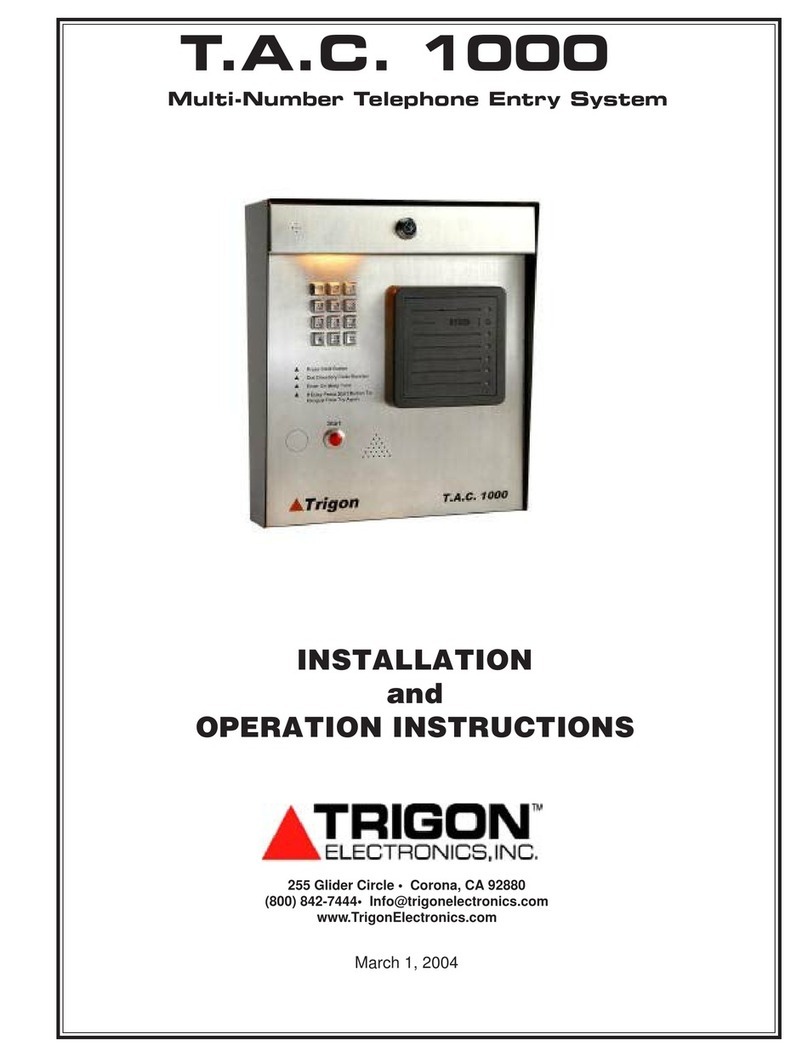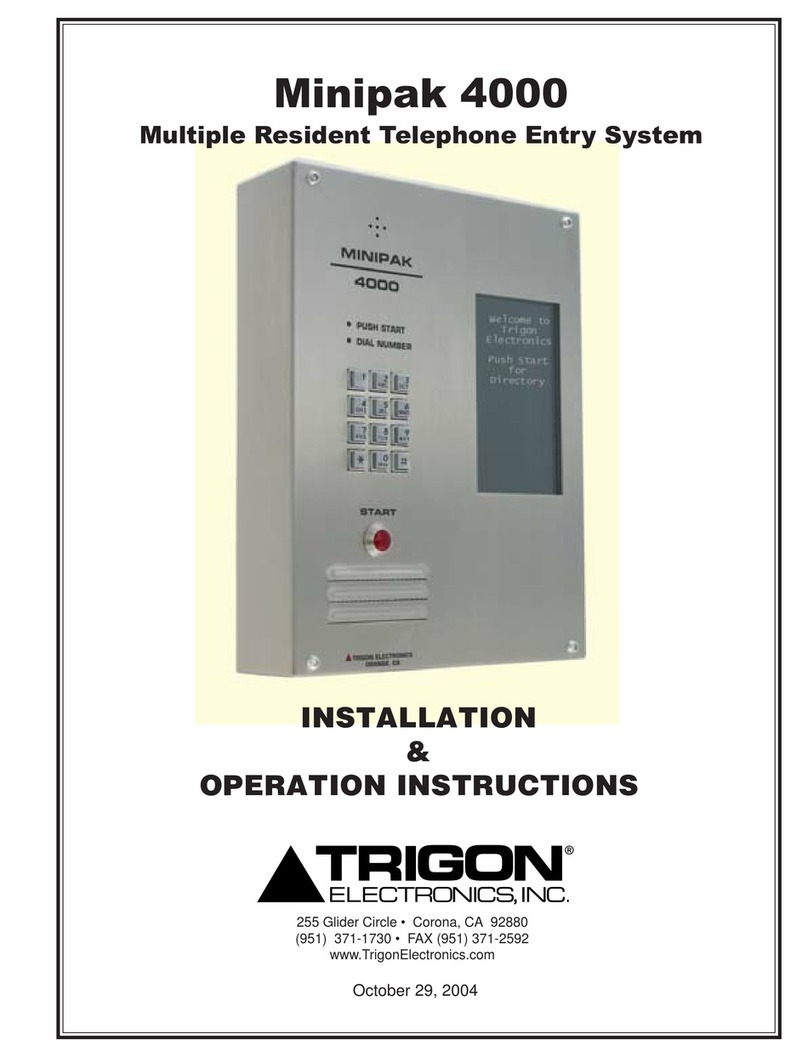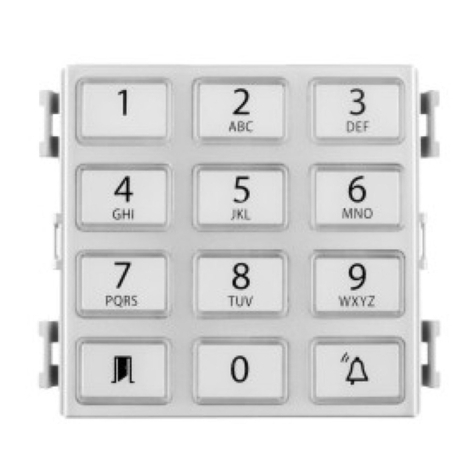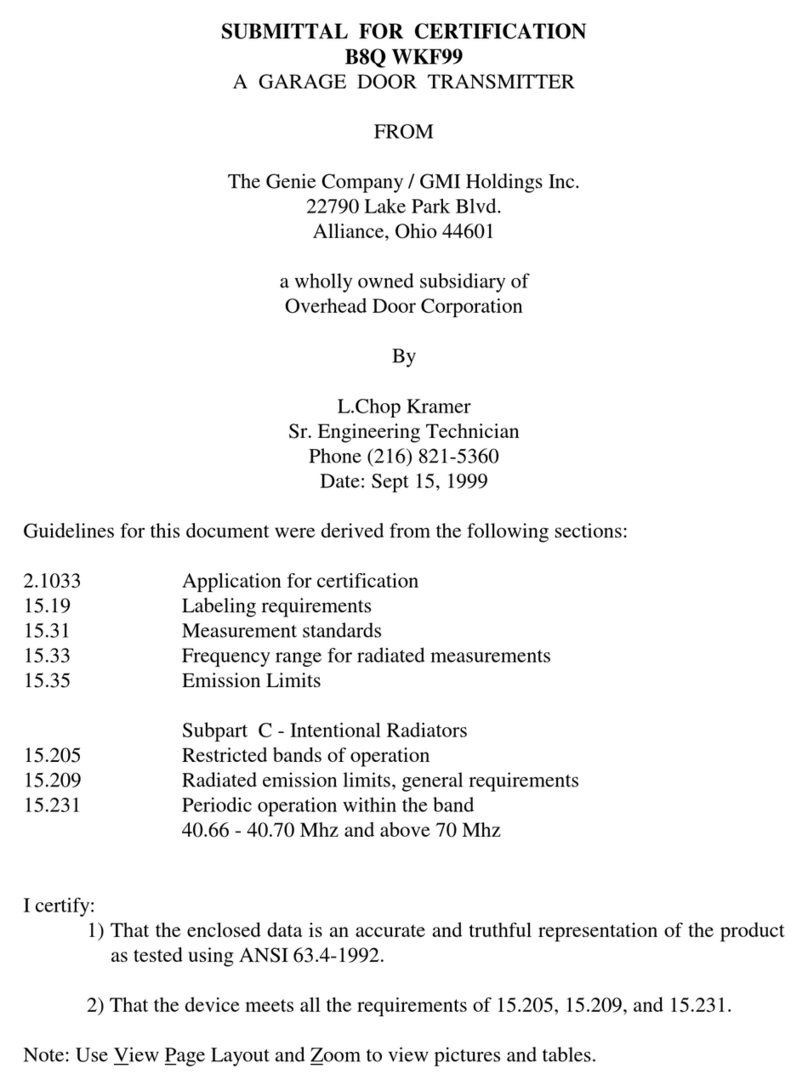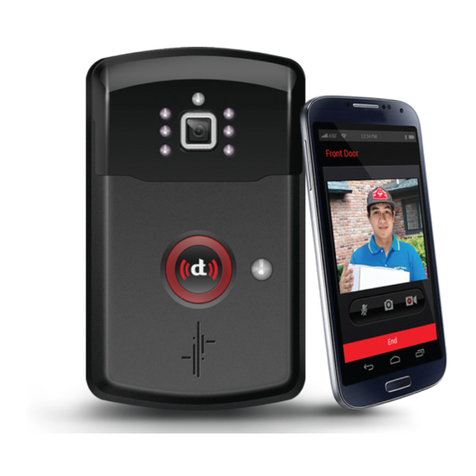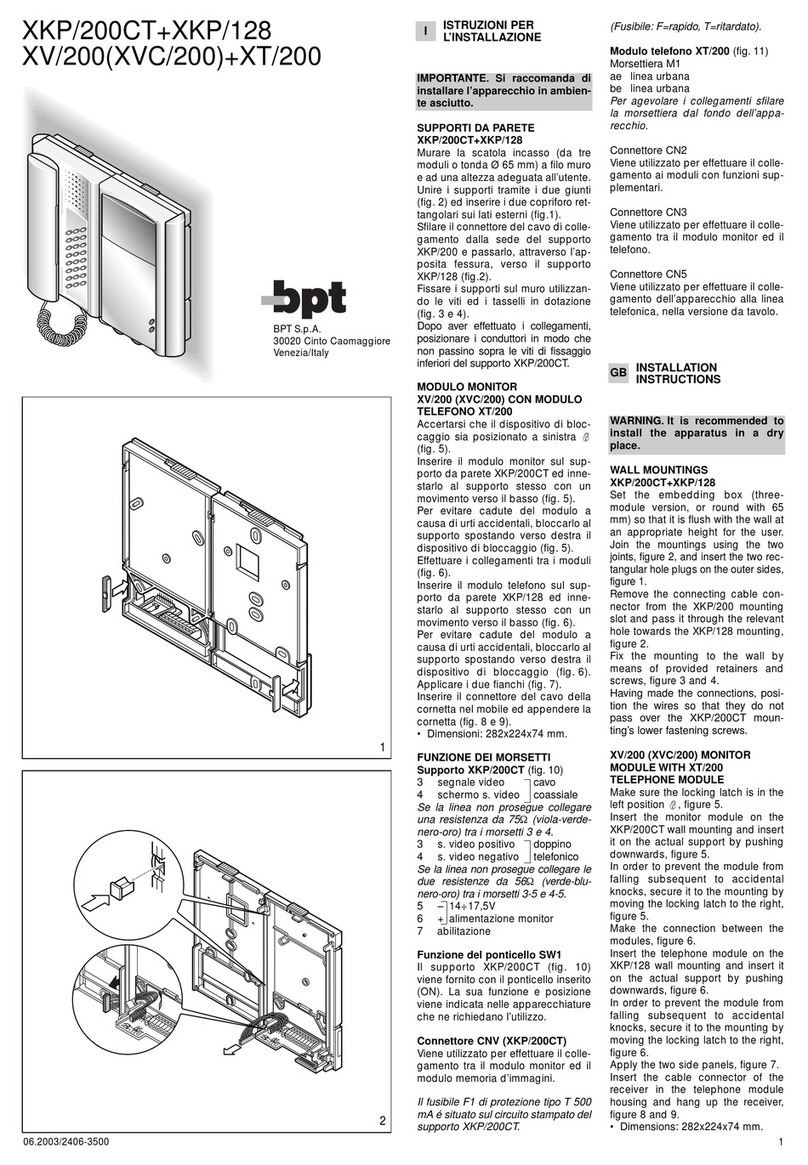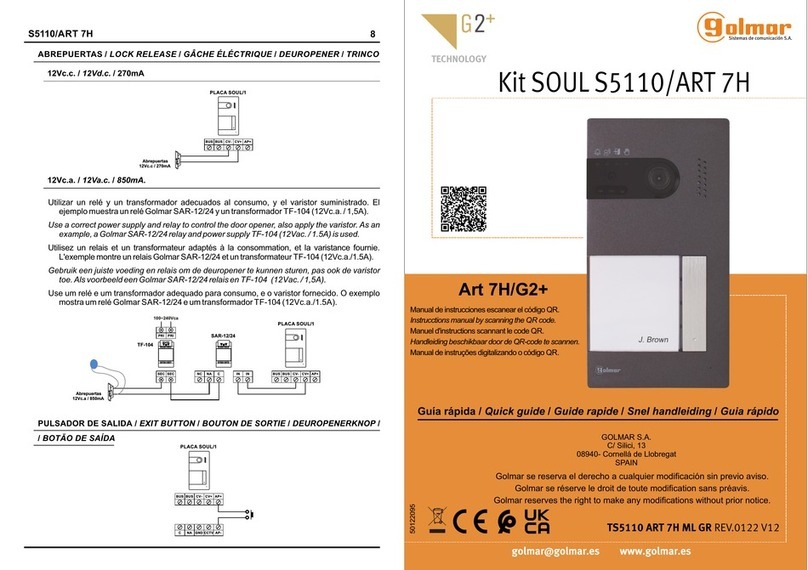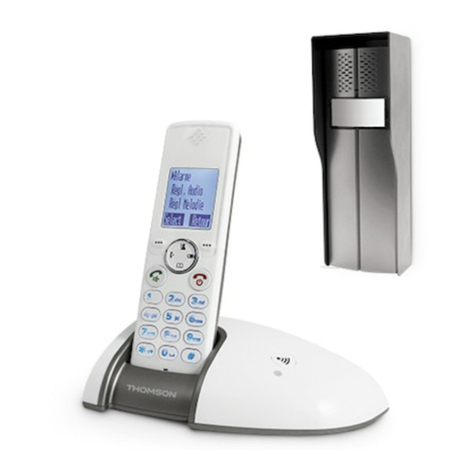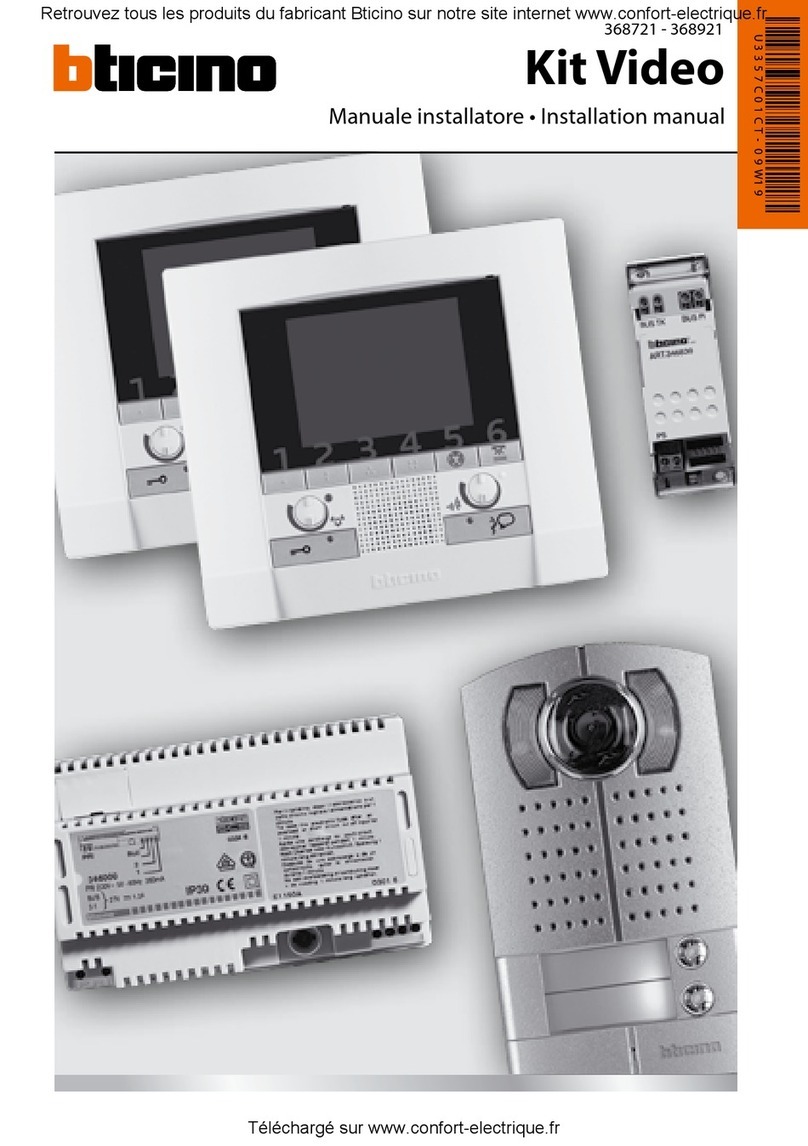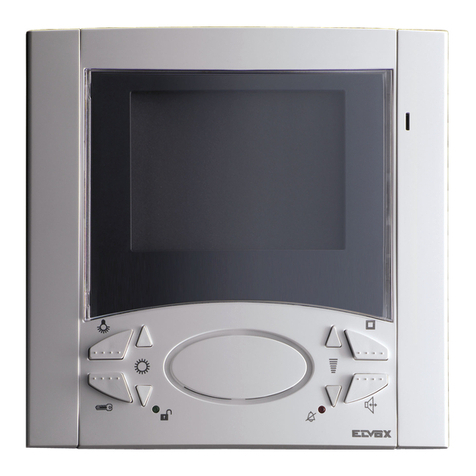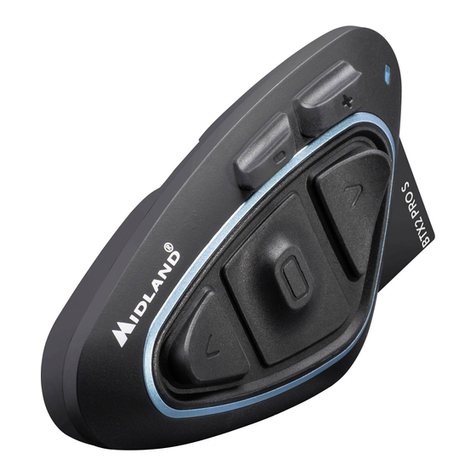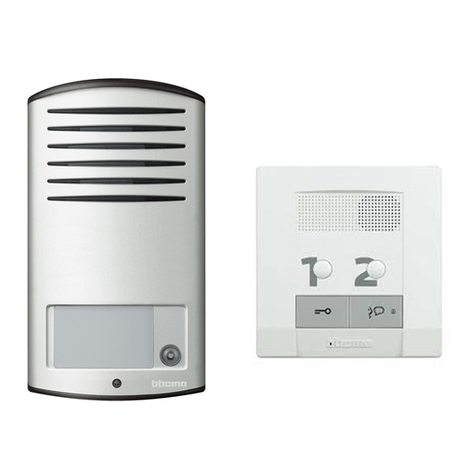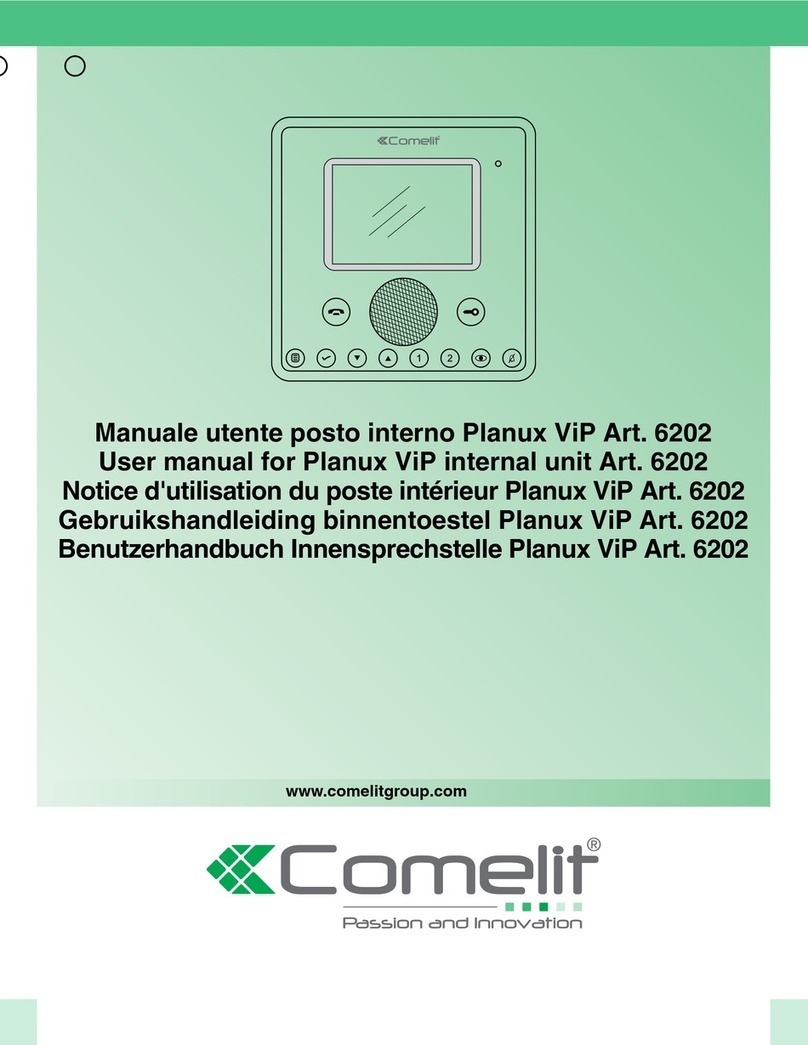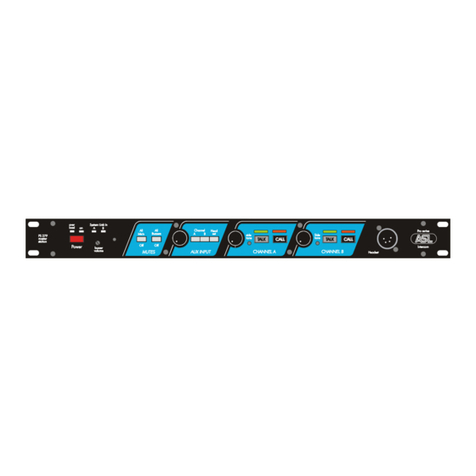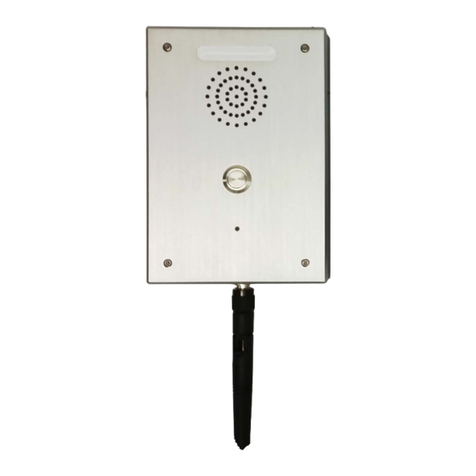Trigon Miniguard HF-2 Series Quick start guide

255 Glider Circle • Corona, CA 92880
(951) 371-1730 • Facsimile (951) 371-2592
www.TrigonElectronics.com
July 22, 2008
Miniguard HF-2 with Prox Reader
or
TELEPROX
Handsfree Telephone Entry Autodialer
INSTALLATION
and
OPERATIONAL INSTRUCTIONS

Page 2
TABLE OF CONTENTSTABLE OF CONTENTS
TABLE OF CONTENTSTABLE OF CONTENTS
TABLE OF CONTENTS
INTRODUCTION ..................................................................................... 3
PRODUCT OVERVIEW .......................................................................... 3
MOUNTING .............................................................................................. 4
WIRING ..................................................................................................... 4
WIRING DIAGRAM ................................................................................ 5
SYSTEM SETUP
Entering Program Mode .......................................................................... 6
Setting Setup Codes ................................................................................ 6
Setting the Relay Duration Timer ........................................................... 6
Setting Incoming Ring Count.................................................................. 6
Setting Call Legnth ................................................................................. 7
Setting Dial Mode ................................................................................... 7
PROGRAMMING
Entering Program Mode .......................................................................... 7
Setting Operational Modes...................................................................... 7
EnteringAutodialed Telephone Numbers ............................................... 7
Verifying Autodialed Telephone Number................................................ 7
Setting the Site ID Number ..................................................................... 7
Deleting Autodialed Telephone Number ................................................. 8
Programming proximity cards................................................................. 8
Changing Program Access Number ........................................................ 8
Deleting proximity cards......................................................................... 8
Master erase.............................................................................................
8
Recording new voice message ................................................................ 9
OPERATION
STANDARD Mode................................................................................. 10
TROUBLE SHOOTING GUIDE
General .................................................................................................... 10
CONDENSED GUIDE TO USE and PROGRAMMING
Security Dept. Operation......................................................................... 11
Standard Mode ........................................................................................ 11
Ring Down Mode Mode.......................................................................... 11
Programming the Unit............................................................................. 11
Revision 11501 Approved

Page 3
INTRODUCTIONINTRODUCTION
INTRODUCTIONINTRODUCTION
INTRODUCTION
PRODUCT OVERVIEWPRODUCT OVERVIEW
PRODUCT OVERVIEWPRODUCT OVERVIEW
PRODUCT OVERVIEW
If you are using this manual as a programming guide
after the initial installation, you may find the TABLE OF
CONTENTS useful in locating the particular
programming procedure you need.
This manual contains all the information required to
install and program the TRIGON MINIGUARD HF-2
with proximity reader and the TELEPROX. If you are
using this manual to install this unit, it is very important
to read all the sections in order.
You should read these instructions before you begin
installation. This will insure that everything is done
efficiently.
The TRIGON HF-2 with proximity reader and
TELEPROX are multi-number auto dialers with the
additional feature of a proximity reader integrated in
thefront of the unitwhichactivates the entry relaywhen
a valid card is entered. If a valid card is not presented,
entry is granted or denied by the remote called party.
Upon pressing the call button, the HF-2/TELEPROX
dials a programmed telephone number. If the number
dialed is busy or does not answer, the HF-2 will hang
up and dial the next programmed number, up to a
maximumof 10. Ifthe last programmednumber is busy
ordoes not answer, the HF-2/TELEPROX will rollover
and start the dialing process again with the first phone
number.
The HF-2 comes standard with 2 output relays. These
relayscan be programmed to operateinseveral different
ways. Relays can be set to pulse momentarily for
camera call-up, they can be set to stay latched on for
the duration of the call, or they can be set to operate for
a timed duration (for door strike operation, etc).
There are two Modes of Operation incorporated in the
HF-2 with keypad entry:
1. The Standard Mode provides timed closure
of the relays and is typically used for access
control.
3. Optional Ring Down Mode: When call call
buttonis pressed, theHF-2/TELEPROX seizes the
telephone line and waits for the PBX to dial a
preprogrammed number.
A Site I.D. code feature provides for unit identification.
The Site I.D. code is a programmable four digit code
that is transmitted by the HF-2 when it receives a
command from the called party. This code, when
interpreted by a Trigon DTMF Decoder, will identify
the calling unit.
Figure 1
TRIGON
TRIGON ELECTRONICS
ORANGE CA.
CALL
HF-2
12"
4.2" 2.0"
Telephone Line-
Voice Grade 24 to 48V
22 AWG;Shielded
or Twisted,2 Conductor
Camera, Dooror Gate
Secondary
Relay
SerialPrinter
(18 AWG; Shielded, 3 Conductor)
Postal
Lock
Box
Primary
Output
Relay
Main Entrance
Power Cabling -
Shielded or Twisted,
2 Conductor,
18AWG up to 250'
16AWG up to 500'
Alarm
Shunt
Relay

Page 4
WIRINGWIRING
WIRINGWIRING
WIRING
MOUNTINGMOUNTING
MOUNTINGMOUNTING
MOUNTING
avoid ground loops, do not ground the shield at both
ends. Use 600V insulated wire for this installation.
7. Isolate the Telco phoneline from 12 VAC power
wires. This will prevent 60 Hz hum from occurring
on the phoneline. Use 22 AWG wire on Telco line
run distances of up to 2400 feet. Consult the factory
for distances greater than 2400 feet.
8. Power Relays 1 and 2 are dry contact, Form C type,
rated for 5 AMPS @ 30 VDC/ 250VAC.
9.The Shunt relay is a low-power (4 watt) reed relay.
It can be used for temporary alarm switch bypass,
video camera activation, etc. The Shunt relay
activates with the #1 or #2 power relay, and
deactivates thirty seconds after relay release.
10.Connect printer wiring to the RS-232 port (Printer
IN to RS-232 OUT, Printer BUSY to RS-232 DSR,
Printer COM to RS-232 COM).
11. If all wiring and grounding is completed, mount the
faceplate onto the backbox.
1.Use the wiring diagram (Fig. 3) for wire connection
information.
2.Do not power any other device from the Trigon’s
12 VAC transformer. If a substitute transformer is
used, be sure it is rated 12 VAC, 40VA, UL Class 2
listed. The 12 VAC input power wires should be
18AWG, 600V, insulated wire. This should be
sufficient for distances up to 250 feet.
3. Do not energize wires until installation is completed.
4. Ground the unit by attaching a separate 12 AWG
ground wire to the ground location on the terminal
block. This ground wire should go to a grounding
rod or grounded metal conduit.
5. Trigon recommends that an EMI filter (Cornell-
Dubilier ModelAPF 1021 or equivalent) be mounted
between the 12 VAC transformer output and the unit.
EMI/RFI filters are available from Trigon. Mount
the filter as close to the unit as possible. Ground the
filter to the same point as unit ground.
6. Shielded cable is recommended. Ground the
shielding to the same point as the unit and filter. To
Arrangements must be made with the local telephone
company for installation of a standard voice-grade
telephone line (touch-tone or rotary) as close to the unit
mounting location as possible. The telephone company
may require the following information.
FCC Registration No..................1Z8898-62546-DI-T
Ringer Equivalence..............................................0.8B
Connector............................................Terminal Block
The unit is designed to be as weather resistant as
possible*. We do however recommend some shelter
from direct rain and sunlight. An overhang is usually
sufficient. Bolt the back plate (Fig. 2) to the mounting
surface using the four .312" holes in the chassis. Feed
the wiring through the access hole in the rear of the
back plate. At this point, the wiring should NOT be
live (energized).
Note: If used in extreme weather, a bead of silicon
sealant should be run around the outside top two thirds
of the unit, after the front case is secured.
(Fig. 2b).
* We offer an optional Lighted Hood for further
protection.
.52" 3.62"
+
+
11.80"
5.38"
2.80"
+
+
3.0"
.52"
1.5"
2.02"
1 Hole
.88" Dia.
4 Holes
.312" Dia.
Note: Mount backplate with 1" wire entry hole
toward the bottom. Seal the opening with a
silicone sealant before attaching backplate to surface.
Figure 2
Figure 2b
Seal top 2/3 of case
to mounting surface.
Side View

Page 5
WIRING DIAGRAMWIRING DIAGRAM
WIRING DIAGRAMWIRING DIAGRAM
WIRING DIAGRAM
Figure 3
Microprocessor
Memory
12VAC/DC NO NC
C
0-250' 18AWG; Shielded
250 to 500' 16AWG; Shielded
500+' 14AWG; Shielded
Input Cable Size
Door Strike
Connections
VoiceGrade 24 to 48V
22AWG; Shielded or Twisted
up to 2400'
Telephone Cable
Telco
Ground
Ear
Mouth
Mic
Spkr
Out
RTS
In
HOOK
DSR
COM
PG
Microphone
Adjustment Speaker
Volume
5 AMP
Primary
Relay
5 AMP
Relay
NO C
Relay #2
Second Relay is Optional
on MGII, 100B, Minipak,
T.A.C. 500,1000,1500
Second Relay is Standard
on HF-2, HS-2, MGIID
100BD, MP4000
Plus
In
Ground
Post al
HEATER
Play
Button
Record
Button
W1
W3
W4
relay 2

Page 6
General Programming Information
The "Initial Setup" for the HF-2 with proximity reader
has been programmed at the factory. The programming
of the unit basically includes programming of the
telephone numbers ti be autodialed when the call button
is pushed, and the acess entry codes.
Record below up to ten (10) autodialed numbers to be
programmed into the HF-2.
PROGRAMMING INFORMATIONPROGRAMMING INFORMATION
PROGRAMMING INFORMATIONPROGRAMMING INFORMATION
PROGRAMMING INFORMATION
Autodialed Numbers
Primary Auto dial Number (16 digit max)
__ __ __ __ __ __ __ __ __ __ __ __
Second Auto dial Number (16 digit max)
__ __ __ __ __ __ __ __ __ __ __ __
Third Auto dial Number (16 digit max)
__ __ __ __ __ __ __ __ __ __ __ __
Fourth Auto dial Number (16 digit max)
__ __ __ __ __ __ __ __ __ __ __ __
Fifth Auto dial Number (16 digit max)
__ __ __ __ __ __ __ __ __ __ __ __
Sixth Auto dial Number (16 digit max)
__ __ __ __ __ __ __ __ __ __ __ __
Seventh Auto dial Number (16 digit max)
__ __ __ __ __ __ __ __ __ __ __ __
Eighth Auto dial Number (16 digit max)
__ __ __ __ __ __ __ __ __ __ __ __
Ninth Auto dial Number (16 digit max)
__ __ __ __ __ __ __ __ __ __ __ __
Tenth Auto dial Number (16 digit max)
__ __ __ __ __ __ __ __ __ __ __ __
Site ID Number-if required Number (4 digits)
__ __ __ __
(A) To Enter Program Mode Remotely:
1. Call the telephone number of the unit.
2. Listen for a single tone.
3. Enter "
✽
" then the unit's Program Code.
If the unit is new, use the preset factory code. (Factory
code is 5269). You will hear two beeps
(B) To Run Initial Setup:
1. Unit must be in programming mode (see above).
2. Enter "#, 0". This tells the unit that you want to
run SETUP. No beeps will be heard.
Enter Telephone Code Length:
Note: Telephone code length for the HF-2 must be two
digits in length.
3. Enter the telephone code length. 2 for two
digits.( ) [ 2 ]
Enter Ring Count:
“Ring Count” refers to the number of incoming rings
the Miniguard II will wait before it auto-answers. This
count is adjustable from 1 to 9.
4. Enter the number that indicates the number of
rings desired. ( ) [ 1 ]
Enter Gate Interval:
"Gate Interval" refers to the length of time the output
relay (parking gate, front entry, etc.) will stay engaged
after the command has been issued.
Forexample: Enter “1” forone 5-second interval. Enter
“2” for two 5-second intervals (10 seconds). Enter “6”
for six 5-second intervals (30 seconds) etc.
Note: Nine is the maximum..
5. Enter the number of 5-second intervals
desired. ( ) [ 2 ]
Note: A “0” here will allow the output relay to engage
for a one second pulse
SYSTEM SETUPSYSTEM SETUP
SYSTEM SETUPSYSTEM SETUP
SYSTEM SETUP
General Programming Information:
The "Initial Setup" for the HF-2/TELEPROX has been
programmedat the factory.Thesefactory default settings
may be changed to better suit your particular application.
If you decide to alter these settings, follow the
instructionsbelow. It is important thateachprogramming
step be taken in order. When reprogramming a specific
feature, you must always enter the programming mode
first.You maythen go tothe appropriate proceduralsteps
for the changes desired.
Example: Enter program mode: *5269 (beep, beep)
Enter the setup string #0212100 (beep, beep)
If desired exit program mode by entering ##
This would set the following: Resident code length 2
(i.e. 000 to 999), auto answer ring count 1 (i.e. 1 ring),
gate/door open interval 2 (i.e.10 seconds), call length 1
(i.e.1 minute), dialmode 0 (i.e,touch tone), latchenable/
disable 0 (i.e. disabled)

Page 7
Enter Call Length:
“Call Length” refers to the maximum time (in minutes)
that the unit will allow a conversation to last.
6. Enter the number (1 thru 4) that corresponds to
the call length time (in minutes) that is
desired. ( ) [ 1 ]
Note: A “0” here allows indefinite call length, however
the unit will auto disconnect after 30 seconds of voice
silence.
Enter Dial Mode:
“Dial Mode” refers to the type of signal the unit uses to
dial a telephone number. The HF-2/TELEPROX is
capable of dialing rotary/pulse or touch-tone.
Enter "0" for Touch-tone dialout
7. Enter dial mode desired ( ) [ 0 ].
Enter Latch Enable/Disable:
“Latch Enable/Disable” refers to the ability of the
Miniguard II to latch (hold closed) the #1 relay, from a
remote location.
Enter " 1 " to enable the latch feature for relay #1.
Enter" 0 " to disable this feature.
8. Enter latch mode desired ( ) [ 0 ].
You will hear two beeps. . . .setup complete.
9. Enter "# #" to exit Program Mode, otherwise,
continue programming by entering the desired
function code.
PROGRAMMINGPROGRAMMING
PROGRAMMINGPROGRAMMING
PROGRAMMING
General Programming Information:
The "Initial Setup" for the Miniguard HF-2 with
proximity reader has been programmed at the factory.
The programming of the unit focuses on the progam
mode, the telephone numbers to be autodialed, the site
ID number, and the desired entry codes. It is important
that each programming step be taken in order. When
reprogramming a specific feature, you must always enter
the programming mode first. You may then go to the
appropriate procedural steps for the changes desired.
Note: It is recommended that you read thru all of the
following sections first, before any change is attempted.
This will familiarize you with the procedure required.
Recordany programmed informationyouwish to change
in the spaces ( ) provided. Factory default is displayed
in brackets [ ].
(A) To Enter Program Mode:
(B) Setting Operational Modes:
Thesesettings determine howtherelayswill function.
Except when noted, each of the following program
commands will result in two (2) tones (high/low)
signifying their completion and acceptance.
Standard Mode allows the relays to be activated for a
specified time period (such as for access control
purposes).
Optional Ring Down Mode: When call call button is
pressed, the HF-2 seizes the telephone line and waits
for the PBX to dial a preprogrammed number. This
call may only be terminated by the called party.
1. Unit must be in Program Mode.
2. Press '7' then press '2' to set unit for Ring
Down Mode.
3. If desired, exit Program mode by pressing '#'
(wait for two second tone).
(C) Setting the Primary and Backup Telephone
Numbers:
1. Unit must be in Program Mode.
2. Press '0' then '0' (wait for tone) and enter the
first phone number. Press '#' when complete.
Press '0' then '1' (wait for tone) and enter the
second phone number. Press '#' when complete.
If more numbers are needed press '0' then '2'
(wait for tone) and so on for up to 10 phone
numbers. Press '#' when complete.
3.If desired, exit Program Mode by pressing '#'
4.If remotely programming press '7'. to terminate
call.
This number identifies the unit upon request from a
central office.
(D) Setting the Site ID Number:
1. Unit must be in Program Mode.
2. Press '#8' .
3. Enter a four digit number.
You willhear two 'beeps'indicating command accepted.
4. If desired, exit Program Mode by pressing '#'
(wait for two second tone).
5. If remotely programming press '7'. to terminate
call.
1. Unit must be in Program Mode.
2. Press '7' then press '0' to set unit for standard
mode.
3. If desired, exit Program Mode by pressing '#'
4. If remotely programming press '7'. to terminate
call.
(a) Enter Program Mode Remotely:
1. Call the telephone number of the unit.
2. Listen for a single tone.
3. Enter "
✽
" then the unit's Program Code.
If the unit is new, use the preset factory code. (Factory
code is 5269). You will hear two beeps

Page 8
(E) Deleting Telephone Numbers:
1. Unit must be in Program Mode (see section A).
2. Enter the two-digit code for the number you
wish to delete. (0,0 for primary, (0,1) for
secondary, etc.
You will hear one beep.
3. Enter "#" .
Two beeps indicate Erasure complete.
Repeat steps 2 and 3 until you are finished.
4. Enter "# #" to exit Program Mode, otherwise,
continue programming by entering the desired
function code.
Note: If you wish to change an existing telephone
number, use the instructions for Adding Telephone
Numbers and enter the new number in place of the old
one. The old number will be overwritten.
(F) Programming Proximity Entry Cards:
Entry Codes make it possible for the resident to enter a
Proximity Card at the unit and gain access without
placing a call.
1 Unit must be in Program Mode (see section A).
2 Enter #1
3 Swipe proximity card
4 Wait for one beep
5 If a second card entry is desired, swipe card
6 Wait for one beep
7 Repeat 3 & 4 to program all cards needed
8 Enter ## to exit programming
PROGRAMMINGPROGRAMMING
PROGRAMMINGPROGRAMMING
PROGRAMMING
(H) Deleting Proximity Cards:
1. Unit must be in Program Mode (see sectionA).
2. Enter "# 2"
3. Swipe the proximity card that you want to
delete.
You will hear two beeps. Erasure complete.
Three beeps indicate no Code match found.
4. Enter "# #" to exit Program Mode, otherwise,
continue programming by entering the desired
function code.
(I) Master Erase Procedure:
This procedure allows selective or complete deletion of
all data in the Miniguard HF-2's memory. Also, it is
possible to reset the Miniguard HF-2 back to its factory
defaults (presets).
Note: Use caution when performing these steps.
1.Unit must be in Program Mode(see section A),
2. Enter " #
✽
".
3. Enter "0" if you wish to erase all data and reset
unit back to factory defaults.
Upon completion of the full master erase sequence, you
will hear a long series of beeps.
Note: Master Erase time will vary greatly depending on
memory type, usage and capacity.
(G) Changing the Program Code:
This feature allows you to change the Program Code to
something other than the factory preset of 5269.
1. Unit must be in Program Mode (see section A).
2. Enter "# 7"
3. Enter 4 digits for new Program Code.
You will hear two beeps.
4. Enter "# #" to exit Program Mode, otherwise,
continue programming by entering the desired
function code.
Note: The 5269 Code (or any other previous code) is
now invalid, so keep a good, safe record of your new
Program Code for future use.
Note: Ifyou lose the abilitytoaccess the ProgramMode
after performing this step, call TRIGON service. We
havethe ability to remotely resetthe ProgramCode back
to default.

Page 9
PROGRAMMING, Cont.PROGRAMMING, Cont.
PROGRAMMING, Cont.PROGRAMMING, Cont.
PROGRAMMING, Cont.
(K) Voice message length:
The voice message feature is is set up from the
factory as a "Please Enter" message when the
visitor is granted entry by the called party. When
the message has been changed to a "Voice
Location Message" the approximate message
length must be programmed as follows:
1. The unit must be in Program Mode.
2. Press '0'.
3. Press '1' through '9' for the number of seconds
the auto message lasts.
You will hear two 'beeps' indicating command accepted
4. If desired, exit Program Mode by pressing '#'
(wait for two second tone).
5. To terminate call, press '7'.
ExampleExample
ExampleExample
Example "05"sets auto message to 5
seconds.
The next step is to go to the "4n" command to set
the Auto Message Control.
(L) Auto Message Control options:
1. The unit must be in Program Mode.
2. Press '4' then '0' to Disable voice module
completely.
Or: Press '4' then '1' Enable message feature,
speaker on michrophone on. Or: Press '4' then
'2' Enable message feature speaker on
michrophone off.
Or: Press '4' then '3' Enable message feature
speaker off michrophone on.
Or: Press '4' then '4' Enable message feature
speaker off michrophone off
4. If desired, exit Program Mode by pressing '#'
(wait for two second tone).
5. To terminate call, press '7'.
(J) Recording a new voice message.
To change the voice message on the voice chip
follow these steps:
1. Referring to Page 5, move jumpers W1, W3,
and W4 from the out board pair to the inboard
pair.
2. To record a message press the "REC" button
and speak into the microphone on the front of the
HF-2. Message can be up to 15 seconds.
3. To play back the message press the play button
and the message will play through the speaker.
To re-record the message just push the REC
button again.
4. If the play back is satisfactory, re position the
W1, W3, and W4 jumpers to their out board
positions.
If you have changed the message to a Voice
Location Identifier the proceed with the "0n"
command for message length and the "4n"
command for message playback control.

Page 10
NO DIAL TONE
1. Check input power at unit. Should be 12 VAC.
2. Check that unit is properly grounded to a good
Earth ground.
3. Current starved. Increase AC input wire size.
4. Remove power, wait 5 seconds, restore power.
Check for dial tone.
5. Check for phone line. Should be 48-52 VDC
across phone line terminals (on hook).
6. Check VOLUME adjustment on PC board.
7. Check “SPKR” plug on PC board. Make sure
speaker is properly plugged in (Handsfree
units).
8. Verify that contacts and wires are clean and
tight.
CANNOT PROGRAM
1. Incorrect/lost program code.
2. Not entering ' ✽' before program code.
3. Try ‘NO DIAL TONE’ troubleshooting
procedures.
4. Keypad damaged. Check for vandalism.
5. Check that Program Prom/Microprocessor is
fully seated.
6. Unit is in the wrong Operational Mode
OPERATIONOPERATION
OPERATIONOPERATION
OPERATION
TROUBLE SHOOTING GUIDETROUBLE SHOOTING GUIDE
TROUBLE SHOOTING GUIDETROUBLE SHOOTING GUIDE
TROUBLE SHOOTING GUIDE
LOSES MEMORY
1. Electrical noise on power line. Install EMI/RFI
filter.
2. Excessive electrical noise from strike. Use low
current strike.
3. Unit transformer shared with another device (i.e.
door strike).
RESIDENT CANNOT ACTIVATE STRIKE/GATE
1. Tenant not pressing correct number on phone.
2. Strike/gate operator not wired correctly.
3. Missing or incorrect power to strike or gate
operator.
4. Current starved. Increase wire size.
5. Tone may be too brief in duration (cordless
phones, etc.).
AC HUM IN SPEAKER
1. Phone wires running in same conduit asAC
power.
2. Unit not properly grounded.
3. Defective microphone.
RESIDENT CANNOT HEAR VISITOR
1. Defective handset/microphone.
2. Person receiving the call answers in too short a
duration to activate the HF-2 (person must speak
a minimum of 2 seconds to be detected).
STANDARD MODE
When a CALL button is pressed, the HF-2 dials a pre-
programmed phone number and monitors the line for
the following signals:
Busy Signal: The HF-2 will hang up and redial
the number after approximately three busy tones.
Ring Signal: The HF-2 will hang up and redial the
number after approximately six unanswered rings
(36 seconds).
Voice or Touch-tones: This indicates an answer.
The unit then enters the Talk Mode.
Answering the Call From the HF-2
Answer the HF-2 incoming call with a short phrase at
least 3 seconds long. The unit may fail to recognize a
short greeting such as “Hello” and may not turn on the
microphone.
Oncevoicecommunication has been establishedyoumay
then press keys on your touch-tone telephone to do any
of the following:
1. To Activate the Primary Relay and hang up
after time-out, press '0'
2. To Activate the Secondary Relay and hang
up after time-out, press '8'.
Note:Activating either power relay will simultaneously
activate the alarm shunt relay for the relay activation
time plus an additional thirty (30) seconds.
3. To Terminate the Call, press '7'.
Note: The unit will beep twice to warn of auto-call
termination in 10 seconds.
4. To Activate the Secondary Relay, press '9'.
The unit will respond with one beep to indicate that
the relay has been activated.
6. To Retrieve the HF-2s Site ID number, press
'#'.
7. To Enter the Program Mode, press '
✽
',
followed by the four digit Programming Code.
Calling the HF-2 To Grant Access
When a call is placed to the HF-2, the caller can perform
any of the above operations with the following
exceptions:
1. To Enter the 'Talk' Mode, press '2' or any of the
above tones.
2. To Activate the Primary Relay, press '0' or '5'.
You will hear one beep. Enter your four digit
Program Code. The relay will activate for the
preset cycle duration, and providing 1 beep per
second until the end of the cycle.
3. To Activate the Secondary Relay and hang up
after time-out, press '1' or '6

Page 11
Legend:
dDial mode (0= Touch, 1= Rotary)‡
fFive second relay duration time (1, 2,…9)
iiii Site ID number (always use four digits)
lll Call Length Time in seconds (001, …999)
nnn nnnn Phone Number (up to 12 digits)
pppp Program Code
rRing Count (1, 2, …9)
✽The “star” key of the telephone
# The “pound sign” key of the telephone
☎Tones returned by the unit
SECURITY DEPT. OPERATION
When Security personnel receive a call from the unit,
they press key [X] on their telephone to:
STANDARD MODE
[0] Activate Primary Relay then disconnect.
[8] Activate Secondary Relay then disconnect.
[2] Factory Tone Test (answer tone)
[7] Force disconnect (hang up)
[9] Toggle on Secondary Relay (☎= off, ☎☎ = on)
[#] Requests Site ID Number
[✽{pppp}] Enter Program Mode
RING DOWN MODE
[0,5] Cycle Primary Relay
[1,6] Cycle Secondary Relay
[2] Factory Tone Test (answer tone)
[7] Force disconnect (hang up)
[8] Extends current Call Timer 3 minutes
[9] Toggle on/off Secondary Relay (☎= off, ☎☎= on)
[#] Requests Site ID Number
[✽{pppp}] Enter Program Mode
General
Databetween [ ]is a mandatory programkey stroke sequence. Databetween{ } isto be supplied bythe programmer.
Unit responses are shown between ( ).
CONDENSED GUIDE TO USE and PROGRAMMINGCONDENSED GUIDE TO USE and PROGRAMMING
CONDENSED GUIDE TO USE and PROGRAMMINGCONDENSED GUIDE TO USE and PROGRAMMING
CONDENSED GUIDE TO USE and PROGRAMMING

Page 12
Other manuals for Miniguard HF-2 Series
2
Table of contents
Other Trigon Intercom System manuals
